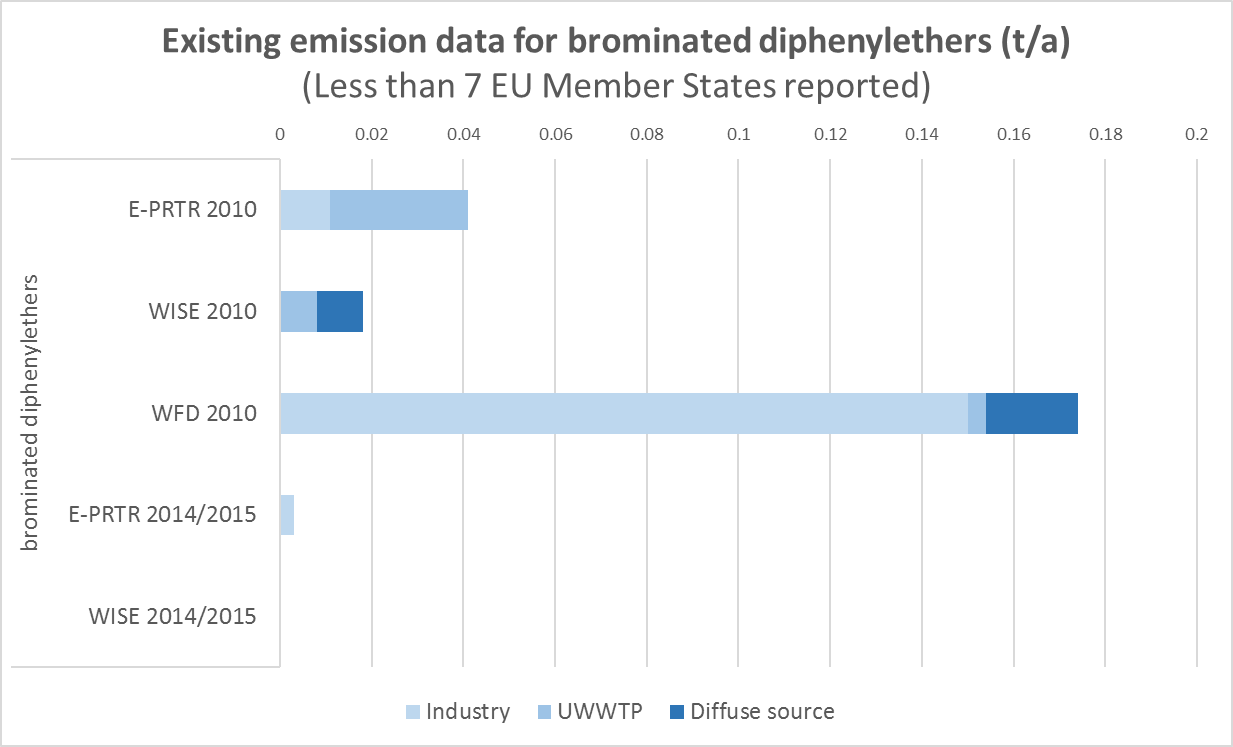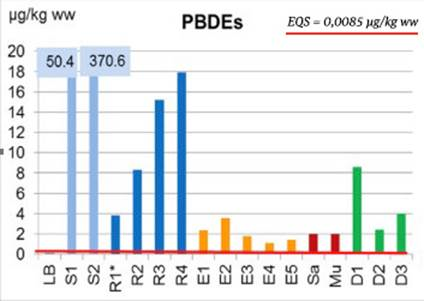Post a comment on the text below
3.5.3. Brominated diphenylethers (pBDEs)
Sources and uses
Polybrominated diphenylethers (pBDEs) are a group of 209 substances which have been used in many products as flame retardants. They have been used, for example, in electronics, furniture and textiles (EPA, 2017).
Toxicity and EQS
pBDEs are ubiquitous in the environment and some are restricted under the Stockholm Convention owing to their widespread use, very persistent and bioaccumulative properties. A group of 6 representative pBDEs is regulated under the WFD[2]. The EQS is set to protect human health from pBDEs consumed in fishery products.
WFD status
The EQS for pBDEs was exceeded in 21% of surface water bodies. Seven Member States reported failures to achieve good chemical status for pBDEs, the vast majority of which were in Sweden (23 185 water bodies of the total 23 320 not meeting the EQS) (see Table 3.1).
Emissions
Figure 3.8 gives an overview of the different reported loads. !!!

Notes: !!! – CAUTION – low confidence in data, as limited reporting of this substance, see Table 3.2. Details on the emissions data are given in Annex A.
There is very little reporting of emissions of pBDEs. The few Member States reporting to the WFD inventory show highest loads from industry, followed by diffuse sources and UWWTP. The few reported diffuse loads suggest atmospheric deposition and households may be relevant sources. In consequence, it is difficult to offer anything quantitative about total emissions to water in Europe, or to discuss trends. Studies can offer some insight (Box 3.2)
Box 3.2 – pBDEs in fish in German rivers
Germany shows widespread and very high exceedance of the EQS (shown by red line) in fig. B3.2, top. Trends between 1995 and 2013 vary between different rivers. The Rhine shows decreasing concentrations, while concentrations in other rivers are mostly increasing.
Fig. B3.2: Brominated diphenylethers in fish of the German Environmental Specimen Bank (left: concentrations 2013; right: trends Year 1995 – Year 2013)


Note: In top chart, letters stand for different lakes and rivers: LB – Lake Belau, S – Saar, R – Rhine, E – Elbe, Sa – Saale, Mu – Mulde, D – Danube. The red line just above horizontal axis shows the EQS of 0.0085 ug/kg. In the lower hand chart, dark bars show trend of decreasing concentrations of pBDEs in fish, blue bars show increasing trend in concentrations.
Source: Fliedner et al, 2016
In contrast to many substances used historically, such as mercury, pBDEs began to be widely used as flame retardants only in the early 1990s. Environmental concerns began to be identified within a few years, with a Directive setting out restriction on use of pentaBDE and octaBDE in 2003 (EC, 2003). In 2008, PBDEs were included in the list of priority hazardous substances under the EQS Directive and in 2009, pentaBDE and octaBDE were listed under the Stockholm Convention (section 1.3). The European Food Safety Agency issued scientific opinions on brominated flame retardants in the food chain 2010-12. Thus regulatory action began relatively rapidly, reflecting the improved understanding of harmful chemicals in the environment and legislative means to act.
Such emissions and pressures information as are reported by countries available suggest that it is not clear how pBDEs are reaching the aquatic environment. The widespread contamination reported by Sweden was attributed to atmospheric deposition. Pathways to soil and water, through waste disposal and washing (which allows pBDEs to enter the sewers and hence UWWTPs) show that most of the pBDEs bind to solid matter (Anderson and MacRae, 2006; North, 2004; Zhang, et al, 2017). Other researchers report a significant atmospheric transport role (Ricklund et al, 2010; Earnshaw, et al, 2013) though brominated flame retardants were not associated with emissions of soot or small particles (Egeback et al, 2012).
Summary/Outlook
One of the striking features about pBDEs is the apparent mis-match between WFD status and emissions reporting. Most Member States reported no emissions of pBDEs under E-PRTR or WISE, with only four Member States reporting some under the WFD inventory.
While the large number of surface water bodies failing for pBDEs can currently be attributed to Sweden, it seems likely that more Member States will report failing chemical status for them in future. This is because of a change in the way in which the EQS is to be measured (from water to concentrations in biota). In the 2nd RBMPs, Sweden applied this new EQS to its chemical status assessment: in future, so will other countries. Although many pBDEs have now been restricted, owing to their chemical behaviour and persistence, it seems likely that they will continue to cycle between biota and sediments for many years.
It is not clear that we fully understand the major transport pathways for pBDEs into the aquatic environment. There is a need to better understand the environmental pathways of pBDEs, to identify whether measures can be implemented which would limit further dispersal.
[1] WISE 2014/2015 Fluoranthene, Industry: 150 t by one country, 0.7 t by 12 other countries; WISE 2014/2015 Fluoranthene, UWWTP: 120 t by two countries, 0.2 t by 5 other countries.
[2] For the group of priority substances covered by brominated diphenylethers, the EQS refers to the sum of the concentrations of congener numbers 28, 47, 99, 100, 153 and 154. Four of them: Tetra, Penta, Hexa and Heptabromodiphenylether (CAS -numbers 40088-47-9, 32534-81-9, 36483-60-0, 68928-80-3, respectively) are regulated as priority hazardous substances.
You cannot post comments to this consultation because you are not authenticated. Please log in.



Previous comments
POLAND
1st paragraph below BOX 3.2.
The reference to section 1.3 in not correct here and should be change to section 1.4. In the meantime reference to section 1.3 should be made after words "the EQS Directive" in the same sentence.
Additionally, from 2017 there is listed also decaBDE in the Stockholm Convention.
DE-UBA:
Please provide Figure B3.2 left in better resolution.